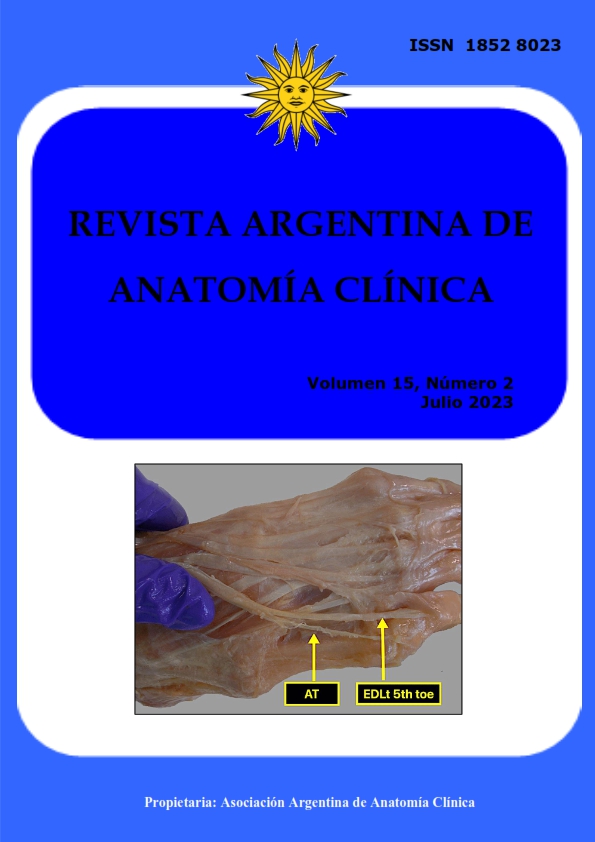Correlation between femoral length and superior gluteal nerve in posterior approaches to the coxofemoral joint
DOI:
https://doi.org/10.31051/1852.8023.v15.n2.40603Keywords:
Superior gluteal nerve, Hip, Safe zone, Femoral lengthAbstract
Objectives: To evaluate the femoral length as a predictor in the location of the superior gluteal nerve in the transgluteal approach to the hip joint. Materials and methods: A cadaveric dissection study was carried out in 15 gluteal regions corresponding to 10% formalized adult cadaveric specimens. Through the transgluteal approach, the SGN and its superior and inferior terminal branches were identified. The distance between the apex of the greater trochanter (GT) and the inferior terminal branch of the SGN was measured, as well as the femoral length. Analysis of variance (ANOVA) was performed to determine significant differences between the GT–SGN distance according to gender and multiple regression to establish whether femoral length and gender are significant predictors of the GT–SGN distance. Results: The mean GT–SGN distance was 49.05 mm (range 39.2 to 59.7 mm) and the mean femoral length for both genders was 41.92 cm. The analysis of variance did not show significant differences in the GT–SGN distance according to sex (p=0.82) and the multiple regression analysis found no significant relationship between femoral length and the GT–SGN distance (p=0.93). Conclusions: The results of this study did not establish a significant correlation between femoral length and the distance between the superior gluteal nerve and the greater trochanter in the transgluteal approach to the hip joint.
Downloads
References
Apaydin N, Kendir S, Loukas M, Tubbs RS, Bozkurt M. 2013. Surgical anatomy of the superior gluteal nerve and landmarks for its localization during minimally invasive approaches to the hip. Clin Anat 26: 614-20.
Barrack RL, Butler RA. 2003. Avoidance and management of neurovascular injuries in total hip arthroplasty. Instr Course Lect 52: 267-74.
Bhatia A, Hoydonckx Y, Peng P, Cohen SP. 2018. Radiofrequency Procedures to Relieve Chronic Hip Pain: An Evidence-Based Narrative Review. Reg Anesth Pain Med 43: 72-83.
Dujardin F, Mure JP, Roussignol X, Lukasiewitch M, Toupin JM, Beccari R, Duparc F, Thomine JM. 2007. Approach of the hip joint by anterior hemimyotomy of the gluteus medius. Approach of Thomine. Interactive Surgery 2: 144-48.
Eksioglu F, Uslu M, Gudemez E, Atik OS, Tekdemir I. 2003. Reliability of the safe area for the superior gluteal nerve. Clin Orthop Relat Res 412: 111-16.
Gore DR, Murray MP, Sepic SB, Gardner GM. 1982. Anterolateral compared to posterior approach in total hip arthroplasty: differences in component positioning, hip strength, and hip motion. Clin Orthop Relat Res 165: 180-87.
Ince A, Kemper M, Waschke J, Hendrich C. 2007. Minimally invasive anterolateral approach to the hip: risk to the superior gluteal nerve. Acta Orthop 78: 86-89.
Jacobs LG, Buxton RA. 1989. The course of the superior gluteal nerve in the lateral approach to the hip. J Bone Joint Surg Am 71: 1239-43.
Kawasaki M, Hasegawa Y, Okura T, Ochiai S, Fujibayashi T. 2017. Muscle Damage After Total Hip Arthroplasty Through the Direct Anterior Approach for Developmental Dysplasia of the Hip. J Arthroplasty 32: 2466-73.
Khan T, Knowles D. 2007. Damage to the superior gluteal nerve during the direct lateral approach to the hip: a cadaveric study. J Arthroplasty 22: 1198-1200.
Lohana P, Woodnutt DJ, Boyce DE. 2010. Sciatic nerve palsy--a complication of posterior approach using enhanced soft tissue repair for total hip arthroplasty. J Plast Reconstr Aesthet Surg 63: e400-e401.
Lüdemann M, Kreutner J, Haddad D, Kenn W, Rudert M, Nöth U. 2012. MRI-based measurement of muscle damage after minimally invasive hip arthroplasty. Orthopade 41: 346-53.
Mayr E, Nogler M, Benedetti MG, Kessler O, Reinthaler A, Krismer M, Leardini A. 2009. A prospective randomized assessment of earlier functional recovery in THA patients treated by minimally invasive direct anterior approach: a gait analysis study. Clin Biomech 24: 812-18.
Nazarian S, Tisserand P, Brunet C, Müller ME. 1987. Anatomic basis of the transgluteal approach to the hip. Surg Radiol Anat 9: 27-35.
Miguel Pérez M, Llusá M, Ortiz J-C, Lorente M, Lopez I, Lazaro A, Pérez A, Götzens V. 2004. Superior gluteal nerve: safe area in hip surgery. Surg Radiol Anat 26(3): 225-29.
Pellicci PM, Bostrom M, Poss R. 1998. Posterior approach to total hip replacement using enhanced posterior soft tissue repair. Clin Orthop Relat Res 355: 224-28.
Rodriguez J, Deshmukh A, Rathod P, Greiz M, Deshmane P, Hepinstall M, Ranawat A. 2014. Does the direct anterior approach in THA offer faster rehabilitation and comparable safety to the posterior approach?. Clin Orthop Relat Res 472: 455-63.
Shaw JA. 1991. Experience with a modified posterior approach to the hip joint. A technical note. J Arthroplasty 6: 11-18.
Downloads
Published
How to Cite
Issue
Section
License
Copyright (c) 2023 Valentín Thomas, Guillermina Pérez Gómez, Brisa de L. Perez Muquini, Juan I. Rossone, Carlos M. Quinteros

This work is licensed under a Creative Commons Attribution-NonCommercial 4.0 International License.
Authors retain copyright and grant the journal right of first publication with the work simultaneously licensed under a Creative Commons Attribution License that allows others to share the work with an acknowledgement of the work's authorship and initial publication in this journal. Use restricted to non commercial purposes.
Once the manuscript has been accepted for publications, authors will sign a Copyright Transfer Agreement to let the “Asociación Argentina de Anatomía Clínica” (Argentine Association of Clinical Anatomy) to edit, publish and disseminate the contribution.



